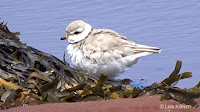PIPING PLOVER
PIPING PLOVER (Charadrius melodus) – (See images below)
DESCRIPTION: The Piping Plover is a small shorebird. In breeding plumage the adults have a narrow white collar lined with black and a small black line across the forehead. The top parts are grey and the under parts are white. Eyes are relative to the head size. The bill is orange with a black tip, and the legs are orange. Non-breeding birds have less pronounced black marks. Sexes are similar. This bird measures around 17 cm (7 inches) in length.VOICE: https://www.xeno-canto.org/species/Charadrius-melodus
NAME: The bird’s English name ‘Plover’ comes from Latin ‘pluvialis’, rain. But according to author Choate there’s no justification for the association of this bird with rain. As for ‘Piping’ in the English name, it refers to its calls and songs. The Latin genus name ‘charadrius’ is from ancient Greek and refers to a bird found in ravines or river valleys. The Latin species name ‘melodus’ refers to the pleasant song of this bird.
HABITAT: Shorelines such as rocky shores or sandy beaches.
DIET: This bird is foraging for insects, crustaceans and other invertebrates in the sand or mud.
NESTING: The piping plover is nesting on beaches near the vegetation line, away (usually) from the water. In this article however a nest that was on the tide line was successfully relocated. The nests are highly vulnerable to disturbance and predators, including dogs being let loose on the beach by their owners. Between two and four light beige eggs are laid, which are incubated by both parents. Chicks can feed themselves soon after birth, but both parents brood them for protection.
DISTRIBUTION: There are two main populations in Canada, the marine eastern one (Atlantic coast) and the freshwater mid-west one (Great Plains). Its wintering range covers mainly the coastal areas of the southeast USA and the Caribbean.
Distribution map: https://en.wikipedia.org/wiki/Piping_plover#/media/File:Charadrius_melodus_map.svg
ON PEI: The piping plover is nesting on Prince Edward Island and is still fairly common in spring and summer.
CONSERVATION: The piping plover is listed as endangered as there are only a few thousands of these birds left in the wild. On Prince Edward Island Island Nature Trust is implementing various measures to protect this bird. One of them is the closure of beach areas where and while it is nesting. So it was great news when 18 chicks fledged in the summer of 2018 on Prince Edward Island. Scientists have obtained new information on what happens to the piping plover in its wintering range, and efforts are made to help protect the birds there as well.
SIMILAR SPECIES: Semipalmated Plover, Killdeer (larger), Common ringed plover
REFERENCES: https://en.wikipedia.org/wiki/Piping_plover
http://www.hww.ca/en/wildlife/birds/piping-plover.html (Hinterland Who’s Who)
https://www.canada.ca/en/environment-climate-change/services/species-risk-public-registry/recovery-strategies/piping-plover-2012.html
https://www.dec.ny.gov/animals/7086.html
https://www.fws.gov/mountain-prairie/es/pipingPlover.php
https://www.audubon.org/field-guide/bird/piping-plover
American Bird Conservancy (Piping Plover)
https://www.ontario.ca/page/piping-plover
https://www.borealbirds.org/bird/piping-plover
https://www.mba-aom.ca/jsp/toc.jsp (Maritimes Breeding Bird Atlas)
http://www.nhptv.org/natureworks/pipingplover.htm (New Hampshire PBS)
https://www.biologicaldiversity.org/species/birds/piping_plover/index.html
 |
| Piping plover, PEI, by Lois Kilburn |
 |
| Piping plover chick, NY, by Beaun |
 |
| Piping plover and chick, Bear Golden Retriever |
 |
| Piping plover, PEI, by Sara Deveau |
 |
| Piping plover chick, PEI, by Lois Kilburn |